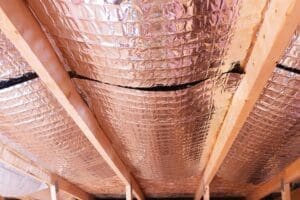Welcome back to the Home Services Home Show! Our goal is to help homeowners like you make smarter, more informed decisions about your homes. Sometimes that means sharing things you need to know, and other times… maybe a little more than you asked for.
On our last episode, we hit a topic that really took off—ductwork in the attic. This topic got way more attention than we ever expected, so we thought it was worth a deeper dive—and a quick clarification.
Why Attic Ductwork Is a Bad Idea (Here in Wisconsin)
In Wisconsin, it makes little sense to run ductwork through an attic. Why? Because our climate isn’t built for it. We get both extremely cold winters and hot summers, and we typically build homes with basements. That’s where we run HVAC systems—below the frost line, in conditioned space—so things don’t freeze up or lose efficiency.
But in the job we referenced in a previous episode, the homeowners couldn’t cool two rooms. Why? Because their attic had hundreds of feet of ductwork, and their AC air handler was located at the far end of the house, almost in the garage.
By the time the air traveled through those ducts, it went from 55°F (as it left the handler) to 80°F by the time it reached the rooms. They were aiming for 72°F. No chance.
The Science of Heat Loss in Attic Ducts
Let’s break it down with some quick numbers.
-
Cool air starts at 55°F
-
Attic air is 130–140°F in summer
-
The duct insulation is usually rated R-3 to R-6
That’s a massive temperature differential with minimal protection. Compare that to your ceiling insulation, which is typically R-60. That’s 20 inches of material separating your cooled home from the hot attic. Yet we run critical HVAC air through poorly insulated ducts with just 1 inch of insulation? Doesn’t make sense.
If your home has attic ductwork, especially in a climate like Wisconsin’s, it’s no wonder you’re struggling with uneven temperatures.
Why We Have Basements (And Why It Matters)
We get asked a lot: “Why do houses in Wisconsin have basements?”
The answer is simple:
-
Basements are cheaper than building up (extra square footage at a fraction of the cost).
-
They’re below the frost line, which is key because water pipes can’t run through exterior walls or attics—they’ll freeze.
-
They give us a conditioned space for ductwork, water lines, and other utilities.
In southern states, where it’s warm year-round, basements aren’t as common. But during the Texas freeze a few years back, millions of dollars in damage happened because attic pipes froze—something we intentionally avoid up north.
How Poor Insulation Ruins Comfort
We hear it all the time—people call and say their kids can’t sleep upstairs in the summer. Even if their AC is running, upstairs bedrooms can be 85°F or hotter. Why?
Because the attic insulation is often inadequate—thin batts of fiberglass that don’t cover evenly. Hot attic air radiates right into those rooms, and no amount of cold air can overcome that heat load.
We’ve gone into homes, upgraded the insulation, and the difference is life-changing. One client told us their kids could sleep upstairs for the first time since moving in. That’s the kind of impact we’re proud to make.
So, What Can You Do?
If your ductwork runs through the attic or you’re dealing with uncomfortable rooms in your house—we can help. Whether it’s:
-
Sealing and insulating ducts
-
Adding proper attic insulation
-
Or identifying the root cause with thermal imaging
We’ll find the real issue and give you a clear, smart plan to fix it right the first time.
Let’s Talk
Got questions about ductwork, insulation, or why your upstairs is hotter than your garage? Give us a call.
-
Larson Home Services (Madison area): larsonhomeservices.com
-
Keeney Home Services (Northeastern WI): keeneyhomeservices.com
We’ve got the tools, the knowledge, and the team to make your home more comfortable—year-round.
Thanks for tuning in. See you next time!




